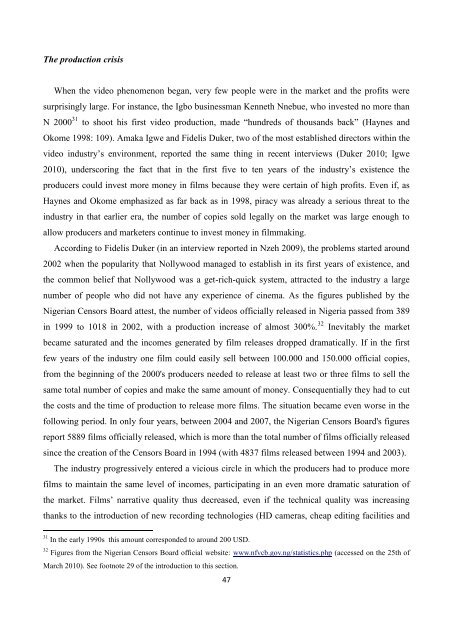Create successful ePaper yourself
Turn your PDF publications into a flip-book with our unique Google optimized e-Paper software.
The production crisisWhen the video phenomenon began, very few people were in the market and the profits weresurprisingly large. For instance, the Igbo businessman Kenneth Nnebue, who invested no more thanN 2000 31 to shoot his first video production, made “hundreds of thousands back” (Haynes andOkome 1998: 109). Amaka Igwe and Fidelis Duker, two of the most established directors within thevideo industry’s environment, reported the same thing in recent interviews (Duker 2010; Igwe2010), underscoring the fact that in the first five to ten years of the industry’s existence theproducers could invest more money in films because they were certain of high profits. Even if, asHaynes and Okome emphasized as far back as in 1998, piracy was already a serious threat to theindustry in that earlier era, the number of copies sold legally on the market was large enough toallow producers and marketers continue to invest money in filmmaking.According to Fidelis Duker (in an interview reported in Nzeh 2009), the problems started around2002 when the popularity that Nollywood managed to establish in its first years of existence, andthe common belief that Nollywood was a get-rich-quick system, attracted to the industry a largenumber of people who did not have any experience of cinema. As the figures published by theNigerian Censors Board attest, the number of videos officially released in Nigeria passed from 389in 1999 to 1018 in 2002, with a production increase of almost 300%. 32 Inevitably the marketbecame saturated and the incomes generated by film releases dropped dramatically. If in the firstfew years of the industry one film could easily sell between 100.000 and 150.000 official copies,from the beginning of the 2000's producers needed to release at least two or three films to sell thesame total number of copies and make the same amount of money. Consequentially they had to cutthe costs and the time of production to release more films. The situation became even worse in thefollowing period. In only four years, between 2004 and 2007, the Nigerian Censors Board's figuresreport 5889 films officially released, which is more than the total number of films officially releasedsince the creation of the Censors Board in 1994 (with 4837 films released between 1994 and 2003).The industry progressively entered a vicious circle in which the producers had to produce morefilms to maintain the same level of incomes, participating in an even more dramatic saturation ofthe market. Films’ narrative quality thus decreased, even if the technical quality was increasingthanks to the introduction of new recording technologies (HD cameras, cheap editing facilities and31 In the early 1990s this amount corresponded to around 200 USD.32 Figures from the Nigerian Censors Board official website: www.nfvcb.gov.ng/statistics.php (accessed on the 25th ofMarch 2010). See footnote 29 of the introduction to this section.47
















